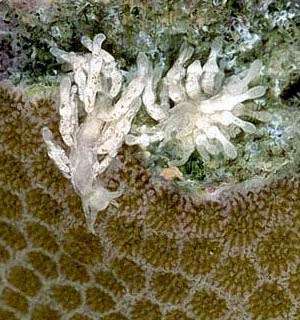
Phestilla minor
Rudman, 1981
Order: NUDIBRANCHIA
Suborder: AEOLIDINA
Family: Tergipedidae
DISTRIBUTION
Tropical Indo-West Pacific.
PHOTO
UPPER RIGHT: on Porites coral colony, 6-7mm long, Touaourou, S of Yaté, New Caledonia, October 1988.
LOWER LEFT: same locality, animal with egg mass.
LOWER RIGHT: 2 animals, 5-7mm long, with "clutch" of egg masses laid under Porites colony, Africana Bch, 1km south of Kunduchi Bch, Dar es Salaam, Tanzania. PHOTOS: Bill Rudman.
RELATED TOPIC
Phestilla minor has previously been reported from East Africa, Hawaii and the Great Barrier Reef, giving it a wide Indo-West Pacific distribution. This small species, seldom more than 7mm long, is always found associated with colonies of the coral Porites, on which it feeds. Its eggs are usually laid alongside the coral colonies. There is one colour form with very little epidermal pigmentation which well matches the colour of the coral colony, and another form which is heavily pigmented opaque white, which matches the shape and colour of small abrasions, probably fish feeding scars, which are found scattered over Porites colonies.
Studies I did in Tanzania showed that P. minor grows rapidly (2 to 9mm in ten days) and starts egg-laying at between 6-9mm. Animals tend to form pairs, (as in P. lugubris), and produce about 10 egg masses, each mass having about 120 eggs. Lecithotrophic (non-feeding) veligers hatch after about seven days and remain in the plankton for a very short time(3-4 days).
Reference:
• Rudman, W.B. (1981) Further studies on the anatomy and ecology of opisthobranch molluscs feeding on the scleractinian coral Porites. Zoological Journal of the Linnean Society, 71: 373-412.
LOWER LEFT: on Porites coral colony, 6-7mm long, Touaourou, S of Yaté, New Caledonia, October 1988., animal with egg mass. LOWER RIGHT: 2 animals, 5-7mm long, with "clutch" of egg masses laid under Porites colony, Africana Bch, 1km S. Kunduchi Bch, Dar es Salaam, Tanzania. PHOTOS: Bill Rudman.
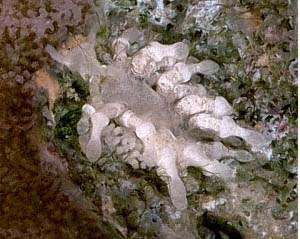
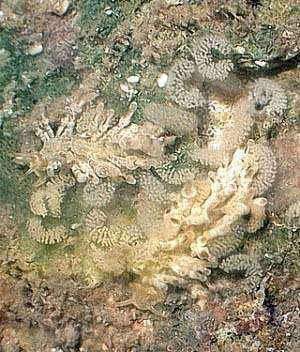
Rudman, W.B., 1999 (May 23) Phestilla minor Rudman, 1981. [In] Sea Slug Forum. Australian Museum, Sydney. Available from http://www.seaslugforum.net/find/phesmino
Related messages
Unknown nudibranch from Bali
November 20, 2009
From: Peter Eyre
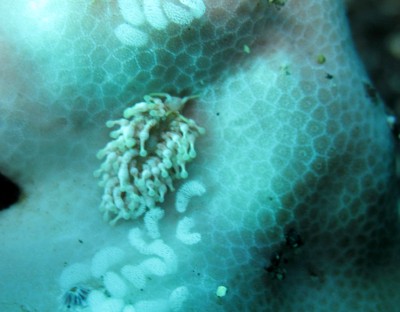
I took this photo at Tulamben, Bali, Indonesia in 2007. This nudi was approx 10 mm in length and was found in less than 5 m depth. Sorry the quality of the photo isn't fantastic
Locality: Tulamben, <5m, Bali, Indonesia, Easter, 2007, volcanic sands. Length: 10mm. Photographer: Peter Eyre.
Peter Eyre
pete_eyre@yahoo.com

Dear Peter,
This is Phestilla minor, a small aeolid which lives on and feeds on species of the coral Porites. If you look at the species Fact Sheet you will see links to information on species that feed on coral. The little sausage-shaped packages in your photo are egg masses laid by the Phestilla. It has a remarkably brief egg and larval stage, and once settled out of the plankton, baby slugs can be laying eggs within a week.
Best wishes,
Bill Rudman
Phestilla minor in sthn Queensland
November 20, 2009
From: Gary Cobb


Concerning message #882:
Hi Bill and everyone!
Well here is another species that appears rare on the Forum. Phestilla minor found here intertidally is quite a surprise, complete with egg mass.
Locality: Pt Cartwright, Mooloolaba, intertidal, Queensland, Australia, Pacific Ocean, 10 July 2004, Intertidal. Length: 8 mm. Photographer: Gary Cobb.
Cheers
Gary Cobb
gary@nudibranch.com.au
Cobb, G.C., 2009 (Nov 20) Phestilla minor in sthn Queensland. [Message in] Sea Slug Forum. Australian Museum, Sydney. Available from http://www.seaslugforum.net/find/21905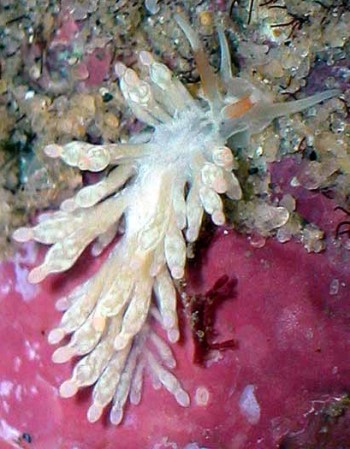
Dear Gary,
Sorry your message seems to have been 'lost'. I found it when I was preparing Peter's [message #22811].
I have never seen a specimen with this reddiah colouration before. Are there any small colonies of the coral Porites in the locality? If not there is always the chnace this is a similar looking species of Cuthona. I must say the swollen tips to the cerata look very like the glandular sacs I would expect to find in a species of Phestilla, so I'll wait to here what you can tell me about the presence of Porites nearby
Best wishes,
Bill Rudman
Another coral-eating aeolid, Phestilla minor,
May 23, 1999
From: Bill Rudman
As promised, here is another coral-eating aeolid, Phestilla minor.
Bill Rudman.
